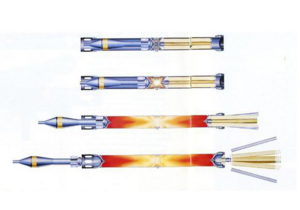Crossbow
| Crossbow Light Anti-Armour Weapon | |
|---|---|
 | |
| Type | Multi-role (anti-armour, anti-fortification, anti-personnel) |
| Place of origin | |
| Service history | |
| In service | 1972–present |
| Production history | |
| Manufacturer | Arthuristan Dynamics |
| Specifications | |
| Weight | 6.3kg |
| Barrel length | 85cm |
| Crew | One |
| Caliber | 67mm |
| Rate of fire | Single shot |
| Muzzle velocity | 230–255 m/s (750–840 ft/s) |
| Effective firing range | 300m |
The Crossbow Light Anti-Armour Weapon is an infantry anti-tank weapon currently in service with the Commonwealth Army. It was introduced in the 1970s to complement the heavier, re-loadable 84mm recoilless rifle as the dismounted rifle section's main anti-armour weapon.
The Crossbow's desginers recognised that infantry anti-tank firepower could be enhanced by giving individual members of the rifle section (squad) the ability to engage and defeat armour on their own with lightweight, single-shot, disposable launchers which could be fired in salvoes.

The Crossbow is no longer capable of defeating the frontal armour of main battle tanks equipped with composite armour or explosive reactive armour. Its role in high intensity warfare has been taken over by the far more lethal MBT LAW. However, its simplicity, low cost and the design's inherent virtues has kept it in production for both domestic service and export.
The Crossbow takes the form of a simple tube made of composite materiel. The firing mechanism is located beneath the tube, the unfolding of which exposes the trigger, while the erstwhile cover serves as the handle. This motion also arms the launcher, which could be made safe again by folding the handle back into its original position. It is aimed with a non-magnified sight located in the box structure attached to the left side of the weapon. A laser sight can be attached to the sight box.
The Crossbow is not a rocket launcher. Rather, it is a recoilless gun. A block of propellant charge is installed at the very centre of the barrel. Pistons are positioned on both sides of the charge. On one end of the barrel is the projectile, on the other a mass of shredded plastic, which serves as the weapon's countermass. Upon firing, the propellant charge detonates, pushing the two pistons apart. One shoots the projectile out of the front end of the weapon, the other ejects the countermass. The pistons latch onto and jam the ends of the barrel after the weapon is fired, sealing it tightly. This not only eliminates the backblast, making the Crossbow perfectly safe to shoot in an enclosed room, but also eliminates any muzzle-blast and gun smoke, rendering the weapon virtually silent and signature-less in operation.
There are three variants of the Crossbow in service. The first fires a HEAT round capable of penetrating about 300mm of rolled homogenous steel armour (modern versions are capable of 450mm of penetration against RHA). The second deploys a HESH warhead which is effective against light vehicles not equipped with spall-liners, and is also significantly more capable against bunkers and other defensive structures. The third is a reloadable training device which shoots a 20mm projectile which is ballistically-matched to a real round.